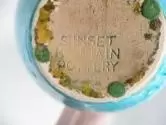Sunset Mountain Pottery That Isn’t

But Sunset Mountain Pottery?
A steady stream of tourists pouring into Asheville after World War I prompted many local businesses to begin offering handcrafted wares for sale: woodcarvings, baskets, coverlets, rustic furniture, hooked rugs and pottery — both traditional salt-glazed utilitarian wares as well as the latest rage: art pottery.
In 1929 tourists who stepped into Hugh Brown’s store The Treasure Chest (1926-1956) or picked up one of his brochures found a new offering: Sunset Mountain Pottery.
While Brown never claimed that his new pottery was actually produced on Sunset Mountain, he touted their finishes as “glazed in gorgeous sunset shades… blending of red and orange tones, or vari-colored greens.” In fact, a close reading of his brochure clearly indicates that “this quaint hand-turned pottery [is] from the ‘Hill Country’ of North Carolina,” a reference to the famous Seagrove area, 200 miles east of Asheville, long known for its pottery.
More recent research by noted author Terry Taylor has determined that Sunset Mountain Pottery was made by J. B. Cole’s Pottery in Steeds, N.C., and resold in Asheville to the tourist trade by both The Treasure Chest and later by Three Mountaineers. One advertisement for a three-handled vase described it as “ready to receive your garden blooms and to add the glow of a gorgeous mountain sunset to the corner to which you place it — this lovely hand-turned Pottery Vase.”
The shapes of Sunset Mountain Pottery are consistent with those associated with the Seagrove area potters, who made the transition from 19th century storage vessels to 20th century decorative art pottery. Classical shapes similar to those of Fulper Pottery are often decorated with two or three looping handles. The majority of their pieces were vases ranging from a few inches to twelve inches in height, although some pitchers, bowls and lamp bases were also produced. Production appears to have run from 1929 until 1935.
Collectors often rate Sunset Mountain Pottery according to the desirability of its glazes, which ranged from a snow white glaze matched with a blue interior to classic forest greens, mustard yellows, various shades of red, and gun-metal black. The shopmark is very consistent, having been carved in a block of hardwood so that it could easily be pressed into the soft clay of the unglazed base.
Outside of North Carolina, prices can hover in the $100-$200 range, but when a large vase with a great glaze pops up in western North Carolina, collectors can quickly push it into and beyond the $200-$300 level. And since the majority of pieces may well have left Asheville packed in a suitcase at the end of a vacation, they are likely to show up just about anywhere in the country.
Just don’t plan a visit to their pottery on Sunset Mountain.
Good Luck!
Bruce Johnson

